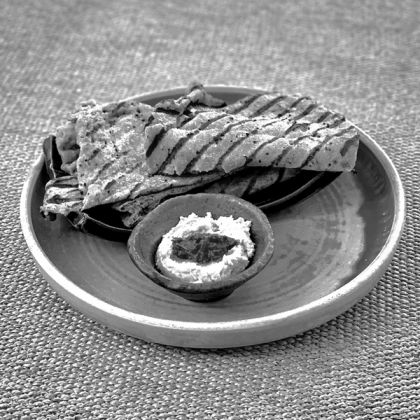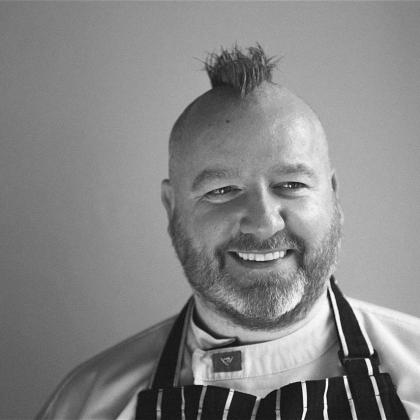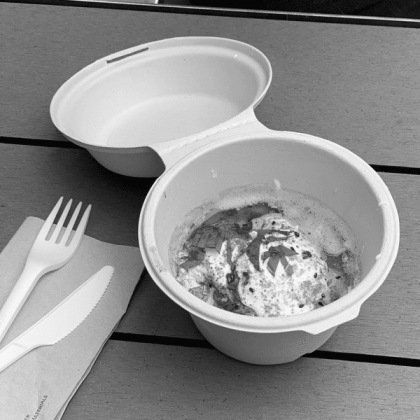The culinary arts provide the most gracious and delicious solutions to environmental and farming problems.
Too many cockerels causing trouble in the hen house? Get out the pot and we shall have coq au vin. What to do with that pig’s head? Let’s brew up a succulent and satisfying brawn, and whilst we are at it, we will use the trotters to make jambon persille – jellied ham.
The great cuisines are full of elegant answers to problems such as these. But now, a new problem faces us, and it is time to take direct action.
On October 10th, The Irish Times reported that “Concerted action will be needed in order to protect Ireland’s population of red squirrels”. The problem is that the red squirrel is being chased from its habitat “largely due to the spread of the more aggressive North American grey squirrel”.
“The grey is chasing the red west”, said Minister of State for Forestry, Mary Wallace. Forestry consultant Dr Michael Carey said that the survey showing the threat to the cute, adorable, bushy-tailed red squirrel from the nasty grey squirrel “has made me much more aware of the complex issues surrounding biodiversity and the fine balance in nature between one species and another”.
Mysteriously, the report did not propose any solution, and the Minister didn’t appear to have any suggestions as to just what we have to do.
But, cometh the hour, cometh the man with the culinary solution.
On page 50 of his new cookery book Beyond Nose to Tail, the ingenious chef Fergus Henderson, of London’s critically and commercially acclaimed St John restaurants, proposes what is a simple, delicious solution: Braised Squirrel.
The recipe is simplicity itself, and can be upscaled should your guests want more than one squirrel each. Simply brown some shallots in duck fat, add the skinned and jointed squirrels and brown them with some pieces of bacon. Add dried mushrooms – for that suggestive woodland note, I guess – and some garlic, add Fergus’s wonderful “Trotter Gear” (a stock made with pig’s trotters), and season. Bung it in a gentle oven for two and a half hours, and when the flesh is tender and yielding, serve simply with some watercress. Voila! A culinary solution to an environmental problem.
Now, many people may not opt for this solution, because many people will find the idea of eating squirrel simply nauseating, despite its popularity in Arkansas, and I am not forecasting that Ms Wallace will direct a Forestry Department team to go forth and to bring back grey squirrel to be served at all future State banquets.
But, “And when did you last eat a squirrel” is a question many of us should actually be asking ourselves, and each other.
What prompted this reflection is not actually the sad plight of the cute red squirrel at the bushy-tailed bullying of the grey squirrel – “The grey is literally the tree rat” said Ms Wallace, inflicting eternal PR damage on the species’ chances of ever enjoying its own Pixar movie.
It was instead alerted by the fact noted by the writer Colin Tudge, in his book So Shall We Reap, that the ¡Kung tribesmen of the Kalahari, one of the last of the hunter-gatherer tribes, enjoyed a diet that “included about 105 different kinds of plant – far more than ours is likely to do”.
Mr Tudge’s sarcasm is a little too gentle. The ¡Kung’s 105 varieties of plant food is likely to be 100 more varieties than the plant foods consumed by very many of us. Count the number of plant foods you have eaten in the last week. A dozen? Ten?
So the issue is not just, “And when did you last eat a squirrel?” It is also, “And when did you last eat turnip/chickpeas/spinach/quinoa/porridge oats?”
And while we are at it, “When did you last eat liver/tongue/oxtail/game? Or mullet/squid/oysters? Or pomegranate/plum/pear/gooseberry?”
For a sizeable proportion of Irish men, for example, the answer to that last question will be “Never”.
10% of Irish men don’t eat fruit.
I know that because Dr Marion Faughnan, of Safe Food, a department of the Food Safety Promotion Board, explained it recently to an audience at the West Cork Food Festival in Skibbereen.
Ms Faughnan also pointed out a few other realities about our un-¡Kung-like modern diet: 1 in 4 kids are obese; we eat too much of refined foods and not enough wholefoods; most breakfast cereals are sugary cereals; most kids get fruit from fruit juice; 28% of boys and 37% of girls have low calcium intake; our meat intake is too high in processed meat which is laced with salt and fat; our fish consumption is too low.
So, the world may well be our oyster, but presented with the mighty mollusc, and many other health-bearing, health-giving foods, we suddenly lose our appetites, and don’t feel hungry
Ms Faughnan’s conclusion was simple and sober: “Using raw ingredients makes for a much healthier diet”. But many of us, clearly, are not using those raw ingredients. Our diets are not merely composed of refined and processed foods, they are composed of a small number of refined and processed foods: lots of battery chicken; lots of processed beef, lots of sausages and mince and poor-quality bread.
So, the solution to our dietary woes, currently breeding an obesity time bomb that will bankrupt our health services, and in the process condemning our children to shortened life spans of increasing ill health, lies with the !Kung, and perhaps the grey squirrel.
We need to get out there and become hunter-gatherers, gathering in a much wider base of raw foods and more diverse foods, protecting Dr Carey’s bio-diversity, and nature’s fine balance, and protecting the fine diversity and balance of our own health. We don’t need to do that hunting and gathering in the wild – a supermarket will do the trick – but we need to eat more of what is good for us.
Too many cockerels causing trouble in the hen house? Get out the pot and we shall have coq au vin. What to do with that pig’s head? Let’s brew up a succulent and satisfying brawn, and whilst we are at it, we will use the trotters to make jambon persille – jellied ham.
The great cuisines are full of elegant answers to problems such as these. But now, a new problem faces us, and it is time to take direct action.
On October 10th, The Irish Times reported that “Concerted action will be needed in order to protect Ireland’s population of red squirrels”. The problem is that the red squirrel is being chased from its habitat “largely due to the spread of the more aggressive North American grey squirrel”.
“The grey is chasing the red west”, said Minister of State for Forestry, Mary Wallace. Forestry consultant Dr Michael Carey said that the survey showing the threat to the cute, adorable, bushy-tailed red squirrel from the nasty grey squirrel “has made me much more aware of the complex issues surrounding biodiversity and the fine balance in nature between one species and another”.
Mysteriously, the report did not propose any solution, and the Minister didn’t appear to have any suggestions as to just what we have to do.
But, cometh the hour, cometh the man with the culinary solution.
On page 50 of his new cookery book Beyond Nose to Tail, the ingenious chef Fergus Henderson, of London’s critically and commercially acclaimed St John restaurants, proposes what is a simple, delicious solution: Braised Squirrel.
The recipe is simplicity itself, and can be upscaled should your guests want more than one squirrel each. Simply brown some shallots in duck fat, add the skinned and jointed squirrels and brown them with some pieces of bacon. Add dried mushrooms – for that suggestive woodland note, I guess – and some garlic, add Fergus’s wonderful “Trotter Gear” (a stock made with pig’s trotters), and season. Bung it in a gentle oven for two and a half hours, and when the flesh is tender and yielding, serve simply with some watercress. Voila! A culinary solution to an environmental problem.
Now, many people may not opt for this solution, because many people will find the idea of eating squirrel simply nauseating, despite its popularity in Arkansas, and I am not forecasting that Ms Wallace will direct a Forestry Department team to go forth and to bring back grey squirrel to be served at all future State banquets.
But, “And when did you last eat a squirrel” is a question many of us should actually be asking ourselves, and each other.
What prompted this reflection is not actually the sad plight of the cute red squirrel at the bushy-tailed bullying of the grey squirrel – “The grey is literally the tree rat” said Ms Wallace, inflicting eternal PR damage on the species’ chances of ever enjoying its own Pixar movie.
It was instead alerted by the fact noted by the writer Colin Tudge, in his book So Shall We Reap, that the ¡Kung tribesmen of the Kalahari, one of the last of the hunter-gatherer tribes, enjoyed a diet that “included about 105 different kinds of plant – far more than ours is likely to do”.
Mr Tudge’s sarcasm is a little too gentle. The ¡Kung’s 105 varieties of plant food is likely to be 100 more varieties than the plant foods consumed by very many of us. Count the number of plant foods you have eaten in the last week. A dozen? Ten?
So the issue is not just, “And when did you last eat a squirrel?” It is also, “And when did you last eat turnip/chickpeas/spinach/quinoa/porridge oats?”
And while we are at it, “When did you last eat liver/tongue/oxtail/game? Or mullet/squid/oysters? Or pomegranate/plum/pear/gooseberry?”
For a sizeable proportion of Irish men, for example, the answer to that last question will be “Never”.
10% of Irish men don’t eat fruit.
I know that because Dr Marion Faughnan, of Safe Food, a department of the Food Safety Promotion Board, explained it recently to an audience at the West Cork Food Festival in Skibbereen.
Ms Faughnan also pointed out a few other realities about our un-¡Kung-like modern diet: 1 in 4 kids are obese; we eat too much of refined foods and not enough wholefoods; most breakfast cereals are sugary cereals; most kids get fruit from fruit juice; 28% of boys and 37% of girls have low calcium intake; our meat intake is too high in processed meat which is laced with salt and fat; our fish consumption is too low.
So, the world may well be our oyster, but presented with the mighty mollusc, and many other health-bearing, health-giving foods, we suddenly lose our appetites, and don’t feel hungry
Ms Faughnan’s conclusion was simple and sober: “Using raw ingredients makes for a much healthier diet”. But many of us, clearly, are not using those raw ingredients. Our diets are not merely composed of refined and processed foods, they are composed of a small number of refined and processed foods: lots of battery chicken; lots of processed beef, lots of sausages and mince and poor-quality bread.
So, the solution to our dietary woes, currently breeding an obesity time bomb that will bankrupt our health services, and in the process condemning our children to shortened life spans of increasing ill health, lies with the !Kung, and perhaps the grey squirrel.
We need to get out there and become hunter-gatherers, gathering in a much wider base of raw foods and more diverse foods, protecting Dr Carey’s bio-diversity, and nature’s fine balance, and protecting the fine diversity and balance of our own health. We don’t need to do that hunting and gathering in the wild – a supermarket will do the trick – but we need to eat more of what is good for us.






